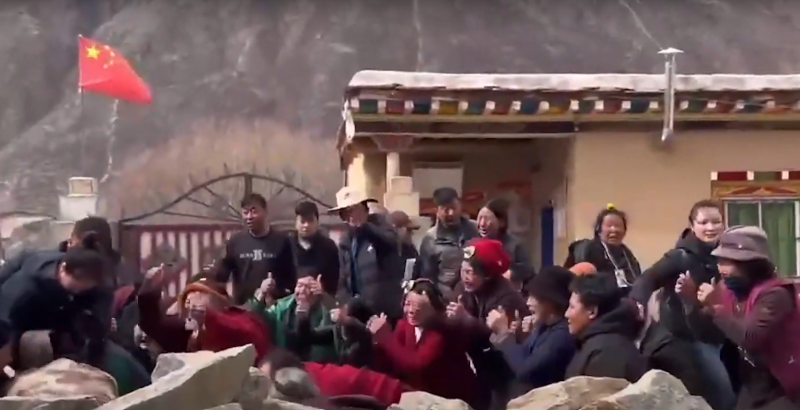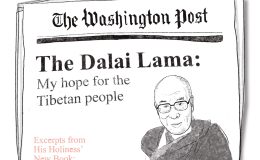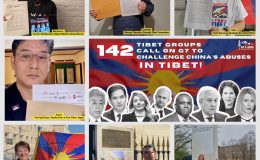FOR IMMEDIATE RELEASE
6 September 2024
Thirteen UN human rights experts [1] have today made public their concerns about the construction of the Kamtok (Ch: Gangtuo) hydroelectric dam on the Drichu River (Ch: Cháng Jiāng / commonly known as Yangtze) in Tibet, warning of “dire and irreversible environmental and climate impacts” and “irreversible destruction of important cultural and religious sites” should it go ahead [2].
The Kamtok dam came to widespread attention in February 2024, when large public protests in eastern Tibet against the dam were broken up by police. Tibetans in Dege and Jomda counties have long opposed the dam, because it would displace Tibetan communities, destroy cultural heritage, and cause severe environmental damage. Research by Tibet groups has found that the dam would displace a minimum of 4,000 Tibetans across the two counties, and submerge two villages [2], as well as six Tibetan monasteries, some of which house precious Buddhist murals more than 500 years old [3].
In their communication to China, the UN experts raised concerns that the dam construction will cause the “forced displacement and relocation of Tibetans”. They noted that this concern extends far beyond Dege and Jomda counties, citing a 2009 announcement by authorities that the broader hydropower development on the Tibetan plateau would see 120,000 residents in the upper reaches of the Yellow River in Qinghai Province relocated from their homes by 2030.
Notably for a hydropower project, the UN experts also raised the “irreversible or significant environmental (biodiversity and climate) impacts” that the Kamtok dam would have. The communication notes that the dam would impact one of the largest rivers on Earth “and an important and strategic area to guarantee water and food security, as well as ecosystem health and climate stability”.
According to the experts, the dam threatens not only Tibet’s fragile biodiversity but also contributes to worsening climate change, as large-scale hydroelectric dams are known to increase greenhouse gas emissions and exacerbate natural disasters like landslides and floods.
Local Tibetans have expressed opposition to the Kamtok dam since plans were first proposed in 2012 [4]. The February 2024 protests were notable for their scale and for the number of images and videos of them, both of which are rare in occupied Tibet due to the intense levels of surveillance and security. Several hundred Tibetans were arrested and detained for opposing the dam’s construction. Research groups noted numerous instances of protesters, including monks, being beaten and denied access to their families. There is no evidence that they have been granted access to lawyers.
The UN experts expressed numerous concerns over this response to the peaceful protests, noting “the widespread crackdown” on Tibetan individuals peacefully expressing their opposition to the construction of the Kamtok dam as well as China’s use of force, arbitrary arrests, and detentions against Tibetans simply exercising their “legitimate” human rights. “These incidents underscore the alarming reality for people living in Tibet, who have faced similar allegations and consequences, for exercising their fundamental rights,” said UN experts.
The Kamtok dam project, developed by a subsidiary of the state-owned enterprise China Huadian Corporation Ltd (Huadian Jinsha River Upstream Hydropower Development Co., Ltd), is part of a broader strategy to export hydropower from Tibet to eastern China.
Yet UN experts state that the relocation of Tibetans from these lands will “adversely [impact] their rights to development and self-determination, to maintain their ways of life, to land and housing, to access and enjoy heritage, to exercise their religious and cultural practices, and their right to a clean, healthy and sustainable environment.”
Their statement spotlights the lack of free, prior, and informed consent from affected Tibetan communities, as well as China’s failure to provide for meaningful consultation about their forced displacement. There are also no indications that any environmental impact assessment that specifically considered the Kamtok project was ever conducted.
The communication was issued to the Chinese government on 8 July 2024 and they were requested to reply within 60 days. As of yet, the Chinese government has failed to issue a response.
Pema Doma of Students for a Free Tibet said, “China’s crackdown on peaceful opposition to this dam project is part of a broader campaign to suppress Tibetan voices and erase our culture. The repression of the Derge protests, including the arbitrary arrests and detentions of hundreds of Tibetans, is a clear violation of their human rights. We call on China to immediately release all those who remain in detention for peacefully exercising their rights and demand an end to Beijing’s systematic oppression of the Tibetan people.”
Lhadon Tethong from Tibet Action Institute said: “With this communication UN experts have confirmed what Tibetans have known all along: China’s so-called development projects in Tibet have disastrous consequences for every aspect of Tibetan life, but the people are not free to object and resistance is truly perilous. The courageous resistance the people of Derge mounted to this devastating dam project shows that the Tibetan people have not lost the will to fight to protect their ancestral lands and precious cultural heritage, even in the Xi Jinping era.
Gloria Montgomery of Tibet Advocacy Coalition said, “This project is threatening the very fabric of Tibetan life—displacing communities, destroying ancient monasteries, and wreaking havoc on the environment. UN experts have sought to shine a light on the injustices Tibetans face and we call on the international community to amplify these concerns, calling on China to immediately halt this project before it inflicts further irreparable harm.”
John Jones from Free Tibet said, “This communication by some of the world’s foremost human rights experts lays bare why the Kamtok dam is such a danger to the people of Dege and Jomda county, and why they need our support. It should prompt fresh efforts from international governments to oppose the dam. It should prompt companies with links to China Huadian, the company behind the dam, to sever them. And it must see the release of any Tibetans who remain in detention for opposing this dam. Not only is their detention unjust, but their concerns have been vindicated.”
“Tibet is often referred to as the ‘Third Pole’ because of its critical role in regulating global climate patterns,” explained Lobsang Yangsto of International Tibet Network. “The destruction of Tibet’s environment through massive infrastructure projects like this one will have ripple effects far beyond the region.The UN’s recognition of this danger is timely and crucial as China continues to trample over the rights of Tibetans, their heritage and environment.”
Ends
Contact:
Lhadon Tethong, Tibet Action Institute: lhadon@tibetaction.net +1 917 418 4181
John Jones, Free Tibet: john@freetibet.org +44 7591 188383)
Pema Doma, Students for a Free Tibet | English or Tibetan language inquiries | pemadoma@studentsforafreetibet.org
Gloria Montgomery, Tibet Justice Center: +447541362001
Rashi Jauhri, International Tibet Network: rashi@tibetnetwork.org +44 7587 094876
Notes for editors:
[1] UN Communication to China, AL CHN 8/2024, 8 July 2024, https://spcommreports.ohchr.org/TMResultsBase/DownLoadPublicCommunicationFile?gId=29120.
Signed by 13 UN mandate holders: Mandates of the Special Rapporteur in the field of cultural rights; the Working Group on Arbitrary Detention; the Working Group on the issue of human rights and transnational corporations and other business enterprises; the Special Rapporteur on the promotion and protection of human rights in the context of climate change; the Special Rapporteur on the right to development; the Special Rapporteur on the human right to a clean, healthy and sustainable environment; the Special Rapporteur on the promotion and protection of the right to freedom of opinion and expression; the Special Rapporteur on the rights to freedom of peaceful assembly and of association; the Special Rapporteur on adequate housing as a component of the right to an adequate standard of living, and on the right to non-discrimination in this context; the Special Rapporteur on the rights of Indigenous Peoples; the Special Rapporteur on the human rights of internally displaced persons; the Special Rapporteur on minority issues and the Special Rapporteur on freedom of religion or belief
[2] Wonpotoe (Wangbuding) township in Derge (Dege (Kardze)) County and Shepa village in Jomda (Jiangda) County (Chamdo (Changdu)
[3] Yena, Wontoe, Khadho, Rabten, Gonsar and Tashi Monasteries.
[4] ‘Tibetans’ appeal against the construction of hydropower stations, and “Running to grab water in Tibet – On the large-scale development of hydropower in Tibet”’, Invisible Tibet, 29 October 2012 http://woeser.middle-way.net/2012/10/blog-post_29.html






Leave a Comment